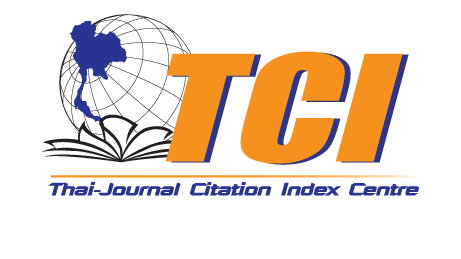การวิเคราะห์ข้อมูลเพื่อการพยากรณ์ความต้องการกำลังคนของตลาดงานในยุคดิจิทัล
DOI:
https://doi.org/10.14456/jiskku.2023.22คำสำคัญ:
การวิเคราะห์ข้อมูล, การพยากรณ์, กำลังคน, แรงงาน, ตลาดงานบทคัดย่อ
บทความปริทัศน์ฉบับนี้ มีวัตถุประสงค์เพื่อนำเสนอผลการสังเคราะห์วรรณกรรมที่เกี่ยวข้องกับการวิเคราะห์ข้อมูลเพื่อการพยากรณ์ความต้องการกำลังคนของตลาดงานในยุคดิจิทัล และศึกษาแนวโน้ม ความต้องการของตลาดงานด้านทักษะของแรงงานในยุคการเปลี่ยนแปลงสู่ดิจิทัล โดยข้อมูลที่นำมาสังเคราะห์ สืบค้นจากฐานข้อมูลออนไลน์ทั้งในประเทศและต่างประเทศ จำนวน 4 แหล่ง คือ ThaiJo, Science Direct, Emerald Insight, และ Springer Link และใช้เครื่องมือสำหรับสืบค้นวรรณกรรมทางวิชาการออนไลน์ จำนวน 2 แหล่ง คือ Semantic Scholar และ Google Scholar ดำเนินการสืบค้นโดยการกำหนดคำสำคัญที่เกี่ยวข้องกับประเด็นที่จะศึกษา เพื่อให้ได้วรรณกรรมที่มีเนื้อหาใกล้เคียงกับหัวข้อของการปริทัศน์ คัดเลือกวรรณกรรมที่ตีพิมพ์ระหว่างปี ค.ศ. 2011 - ค.ศ. 2021 ได้วรรณกรรมเป็นบทความวิจัยและบทความวิชาการ จำนวน 10 เรื่อง โดยแบ่งเป็นบทความภาษาไทยจำนวน 2 เรื่อง และบทความภาษาอังกฤษจำนวน 8 เรื่อง ดำเนินการสังเคราะห์เนื้อหาและสรุปองค์ความรู้ที่เกี่ยวข้องกับการวิเคราะห์ข้อมูลเพื่อการพยากรณ์ความต้องการกำลังคนของตลาดงานในยุคดิจิทัล ผลการปริทัศน์ พบว่า ขั้นตอนวิธีวิเคราะห์ข้อมูลเพื่อการพยากรณ์มีจำนวน 15 เทคนิควิธี ประกอบด้วย EDFR, Documentary Analysis, Box-Jenkins, Winters Additive Exponential Smoothing, Combined Forecasting, Naïve Bayes, Decision Tree, Decision Rules, C4.5, Grey Model, Regression Model, Support Vector Machines, k-Nearest Neighbor, Regression Analysis, และ AODE Algorithm นิยมวิเคราะห์ข้อมูลด้วยโปรแกรม SPSS, Weka, Matlab, SAS, R, และ Visual Basic โดยการวิเคราะห์ข้อมูลจะมีการเปรียบเทียบประสิทธิภาพของเทคนิควิธีที่นำมาใช้ และนำผลการวิเคราะห์ข้อมูลของเทคนิควิธีที่ดีที่สุดไปสร้างเป็นแบบจำลองการพยากรณ์ เพื่อพยากรณ์แนวโน้มอุปสงค์และอุปทาน รวมถึงจำนวนอัตรากำลังคนที่เหมาะสมกับขนาดองค์กรหรือขนาดของโครงการที่กำลังดำเนินงาน นอกจากนี้ แนวโน้มความต้องการของตลาดงาน พบว่า ในช่วงปี ค.ศ. 2020 - ค.ศ. 2025 จะมีการนำระบบอัตโนมัติเข้ามาทดแทนการจ้างแรงงานคนมากขึ้น เช่น การใช้ปัญญาประดิษฐ์ในอุตสาหกรรมการผลิต แต่อย่างไรก็ตาม ยังคงมีความต้องการแรงงานคนที่มีทักษะใหม่หลายด้าน เช่น ทักษะการใช้งาน ดูแล และจัดการเทคโนโลยี ดังนั้น แรงงานจึงจำเป็นจะต้องมีการพัฒนาทักษะตนเองเพื่อให้สอดคล้องกับความต้องการของตลาดงานที่อาจมีการเปลี่ยนแปลงรูปแบบการจ้างงานในยุคดิจิทัล
Downloads
References
Alsultanny, Y.A. (2013). Labor Market Forecasting by Using Data Mining. Procedia Computer Science, 18, 1700-1709.
Akinnuli, B.O., & Apolowo, R.K. (2018). Regression Analysis Based Effective Manpower Planning Methodology: A Case Study. Journal of Engineering Research and Reports, 1(4), 1-12.
Alghamlas, M., & Alabduljabbar, R. (2019). Predicting the Suitability of IT Students' Skills for the Recruitment in Saudi Labor Market. International Conference on Computer Applications & Information Security. (1-5). Saudi Arabia: Riyadh.
Amphanthong, P., & Busababodhin, P. (2014). Forecasting PM10 in the Upper Northern Area of Thailand with Grey System Theory. (In Thai). Burapha Science Journal, 20(1), 15-24.
Arayaphan, W., & Nantasri, C. (2018). Job Market and Social needs for Ph.D. Graduate in Information Studies. (In Thai). Veridian E-Journal Silpakorn University (Humanities, Social Sciences and arts), 11(2), 1073-1089.
Chk, P. (2021). Manpower Group on Thailand Labor Market Trends in 2021. (In Thai). Retrieved form https://brandinside.asia/manpower-group-on-thailand-labour-market-trends-in-2021
Dawson, N., Rizoiu, M.A., Johnston, B., & Williams, M.A. (2020). Predicting Skill Shortages in Labor Markets: A Machine Learning Approach. IEEE International Conference on Big Data (Big Data), (1-14). Atlanta: GA.
Hrnote. (2021). Working Skills for Globalization Era. (In Thai). Retrieved form https://th.hrnote.asia/tips/190809-skills-for-globalization
Katchwattana, P. (2021). 10 Skills World Economic Forum 2025. (In Thai). Retrieved form https://www.salika.co/2021/01/23/10-skills-world-economic-forum-2025
Kamchonkitticoon, W. (2018). Electric Usage Classification using Naïve Bayes and Neural Network. (In Thai) Master thesis in Engineering, Department of Computer and Telecommunication Engineering, Dhurakij Pundit University.
Keerativibool, W. (2016). Forecasting Model for the Number of Employed Person in Thailand. (In Thai). Journal of Science and Technology Ubon Ratchathani University, 18(2), 52-62.
Kingkaew, C. (2014). Review of Predictive Analytics for Big Data in Business. (In Thai). Panyapiwat Journal, 5, 254-217.
Kulvanitchaiyanunt, A. (2020). Big Data Series II: Think Like a Data Scientist. (In Thai) Nonthaburi: Sukhothai Thammathirat University.
Ladybee. (2021). Branding Editor’s Picks Highlight. (In Thai). Retrieved form https://www.thumbsup.in.th/reasons-to-change-your-content-production
Nachev, A., & Teodosiev, T. (2018). Analysis of Employment Data using Support Vector Machince. International Journal of Applied Engineering Research, 13(18), 13525-13535.
Nesdc. (2011). New growth. (In Thai). Competitiveness Newsletter, 3(3), 1-10.
OECD. (2019). Rapid Action Needed for People to Meet Challenges of Changing World of Work. Retrieved form https://www.oecd.org/employment/rapid-action-needed-for-people-to-meet-challenges-of-changing-world-of-work.htm
Pacharawongsakda, A. (2020). A Little Book of Dig Data and Machine Learning. (In Thai). Nonthaburi: IDC Premier.
Pasilatasang, B. (2021). AI by Python Machine Learning. (In Thai). Bangkok: Se-Education.
Piriew, P., Tanupol, N., & Sungrugsa, N. (2017). The scenario of Workforce Development for Support Digital Television of Thailand Industrial in the next 5 Years. (In Thai). Veridian E-Journal Silpakorn University, 10(2),1355-1377.
Pooknilchai, K. (2014). Workforce Demand Forecasting Model Appropriation with Task: A Case Study of CP ALL Co., Ltd. (Public). (In Thai). Panyapiwat Journal, 5(2), 103-119.
Saraubon, K. (2020). Data Science and AI: Machine Learning by Python. (In Thai). Bangkok: Media Network.
Shet, S.V., Poddar, T., Samuel, W., & Kwivedi, Y.K. (2021). Examining the Determinants of Successful Adoption of Data Analytics in Human Resource Management - A Framework for Implications. Journal of Business Research, 131, 311-326.
Siririn, J. (2018). Ethnographic Delphi Futures Research. (In Thai). Retrieved form https://www.salika.co/2018/10/15/ethnographic-delphi-futures-research
Thanomboon, R. (2015). Research for Future. (In Thai). EAU Heritage Journal Science and Technology, 9(1), 74-78.
Thitipattakul, N. (2021). 7 Job of 2022-Job of The Future. (In Thai). Retrieved 10 October 2021, form https://www.disruptignite.com/blog/7-jobs-of-2022
Vaid, K., & Ghose, U. (2020). Predictive Analysis of Manpower Requirements in Scrum Projects Using Regression Techniques. International Conference on Smart Sustainable Intelligent Computing and Applications. (335-344). India: Maharaja Agrasen Institute of Technology.
Wang, C.N., & Nguyen, N.T. (2013). Forecasting the Manpower Requirement in Vietnamese Tertiary Institutions. Asian Journal of Empirical Research, 3(5), 563-575.
Wijayapala, M.P., Premaratne, L., & Jayamanne, L.T. (2016). Employability and Related Context Prediction Framework for University Graduands: A Machine Learning Approach. International Journal on Advances in ICT for Emerging Regions, 2, 1-12.
World Economic Forum. (2021). Top 10 Jobs of the Future - for 2030 and Beyond. Retrieved form https://www.weforum.org/agenda/2021/05/jobs-of-the-future-year-2030
World Economic Forum. (2020a). The Future of Jobs Report 2020. Geneva Switzerland: World Economic Forum.
World Economic Forum. (2020b). These are the Top 10 Job Skills of Tomorrow - and How Long it takes to Learn Them. Retrieved form https://www.weforum.org/agenda/2020/10/top-10-work-skills-of-tomorrow-how-long-it-takes-to-learn-them
Yongsiriwit, K., & Chaisiriprasert, P. (2017). Big Data Analytics for Forecasting Patient Volumes in Thailand using R Programming Language. (In Thai). The 5th Academic Science and Technology Conference. (1-7). Bangkok: ASTC.





